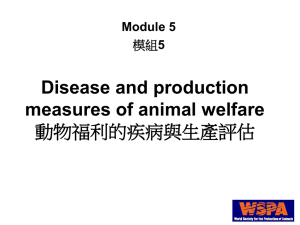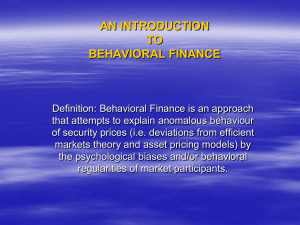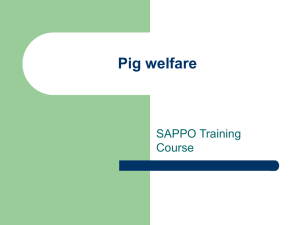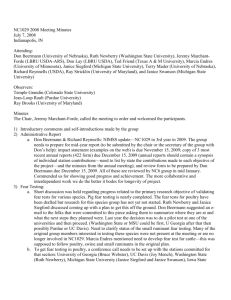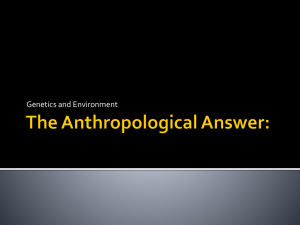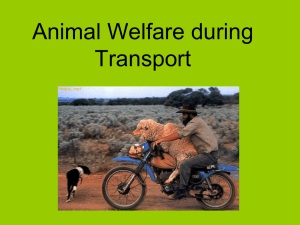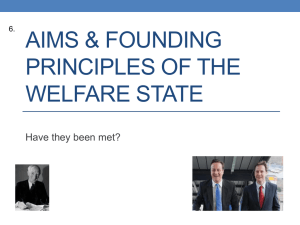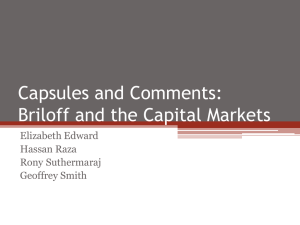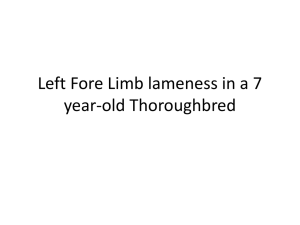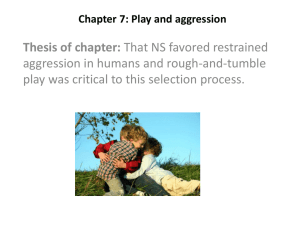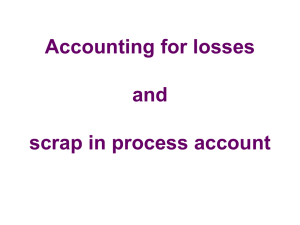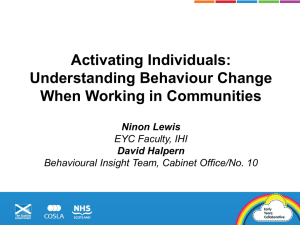7_Behaviour(II) 動物福利的行為學
advertisement
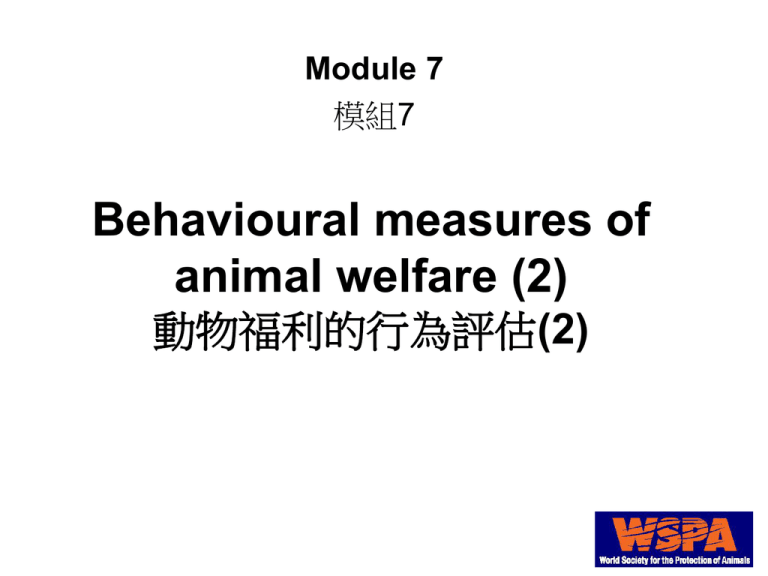
Module 7 模組7 Behavioural measures of animal welfare (2) 動物福利的行為評估(2) This module will enable you to 此模組將使你能夠 • Recognise and interpret behavioural indicators of animal welfare辨認動物福利的 各項行為指標,並解釋其背後意義; • Identify possible causes of abnormal behaviour識別動物展現不正常行為的各種可能 原因 Introduction介紹 • Module 6 – How behavioural indicators are used in research, to identify how animals feel about changes and choices within their environment 模組六說明行為學指標是如何被動物福利學使用, 以認定動物在其環境中如何感受其變化及選擇 • Today’s session – How you can use an animal’s behaviour to learn about the animal’s welfare 本模組將探討如何利用行為學之指標去了解動物福利之狀況 Behavioural indicators - the ‘normal’ animal 正常行為之指標 • • • • • • Alertness 警覺 Curiosity 好奇 Range of activities 行動多樣性 Interaction with other members of the herd/flock 同群動物彼此之互動 Interaction with humans/Aversion to humans 與人類之互動/逃避人類 Play 玩耍 The ‘normal’ animal: Alertness 正常動物:警覺 The ‘normal’ animal: Curiosity 正常動物:好奇 The ‘normal’ animal: Range of activities正常動物:多樣性之行為模式 The ‘normal’ animal: Interaction with other members of group/herd/flock 正常動物:與同窩/群動物之互動 The ‘normal’ animal: Interaction with humans 正常動物:與人類之互動 The ‘normal’ animal: Play 正常動物:玩耍 The ‘normal’ animal: Influence of species, age, breed and sex正常動物行為:受到品種、 年齡、品系、與性別之影響 The experienced stockperson 有經驗的動物管理員 Behavioural indicators of poor welfare 負面動物福利的行為指標 • • • • • Limited range of activity受限的行為能力 Panting and/or sweating 喘氣和/或出汗 Huddling or shivering 擠在一起或發抖 Depression 抑鬱 Abnormal fear or aggression towards humans 對人不正常的恐懼或示威 • Stereotypies and other behavioural abnormalities 刻板性或其他不正常的行為 1a) Limited range of activity 1a)受限的行為能力 May affect individuals or a whole group, and includes: 會影響個體或整群動物,包含: 1. Restricted space in intensive farming systems or laboratory housing 空間受限的集約式農場或實 驗動物舍 2. Close tethering 緊束之頸鍊 3. Lameness 跛行 4. Increased lying time (due to lameness, disease, obesity or weakness) 增加躺臥的時間(因為跛行、 疾病、肥胖、或體弱) 1b) Limited range of activity due to confined housing1b) 因環境受制導致受限的行為能 力 1c) Limited range of activity due to close tethering 1c ) 因緊栓鍊導致受限的行為能力 1d) Limited range of activity due to lameness 1d)因跛足導致受限的行為能力 • • • • • Lame animals suffer as: 跛足是痛苦的,因為: They are in pain 痛 They do not interact normally with other herd members 與其他同籠動物無正常互動 They are often thin because they cannot move easily to feed 因為不易行動進食故瘦 They may suffer urine scalding or develop sores from lying down for long periods 長時間被尿成份造成化學 燙傷,或因為長期躺臥造成褥瘡 1e) Increased lying time due to weakness, disease, obesity 1e)因衰弱,疾病,肥胖增加躺臥的時間 • Weakness衰弱 – Chronic starvation慢性飢餓 – Rapid muscle growth in broilers and turkeys肉雞與火雞肌肉的迅速成長 • Many diseases cause exhaustion or collapse, if they are not treated很多疾病會造成身體的崩潰 • Obesity is an important issue among pet animals肥胖是寵物的重要議題 2. Panting and/or sweating 2呼吸急促與盜汗 • • • • • Heat stress熱緊迫 Fever發燒 Overcrowding密飼 Fear恐懼 Identify the cause確認發生之原因 – ambient temperature?環境周遭的溫度 – stocking density?飼養密度 – signs of disease?疾病的徵兆 3. Huddling or shivering 3. 擠在一起發抖 • Cold 冷 – Does not usually affect most animals except in extreme environments 除非極冷,通常動物不會受影響。 – Often affects very young animals 通常會影響幼年動物 – More likely where animals are wet and chilled by wind 較可能的情況是當動物身體潮濕且有寒風時 – More likely if young animals have not been fed較可能的 情況是幼年動物沒有餵食 • Fear 恐懼 4. Depression 4. 鬱抑 5. Abnormal fear or aggression towards humans 5.對人類不正常的恐懼或示威 ‘Normal’ depends upon species, breed and previous contact with humans 正常行為決定於:(1) 物種; (2)品系; (3)過去與人類相處的經驗。 Animals learn from experience: abnormal fear or aggression may indicate previous cruelty動物從經 驗學習:不正常的恐懼或示威行為表示過去被虐待。 5. Abnormal fear or aggression towards humans: Cows 5.對人類不正常的恐懼或示威:乳牛 Dairy cows who are frequently handled should not be afraid of people 乳牛經常與人接觸不 應該怕人 5. Abnormal fear or aggression towards humans: Pigs 5.對人類不正常的恐懼或示威:豬 • Negative interactions for 15 - 30 seconds daily cause pigs to be less willing to approach stationary humans 每天有15-30秒的時間與豬有負面互動,豬就不願意接 近動物管理員 • Positive interactions cause pigs to be more willing to approach stationary humans對豬正面的互動會使豬願 意接近動物管理員 Time to interaction with stockperson 和管理員互動的時間 (Gonyou et al., 1986) Time to interact (s) 互動所需時間 After negative interaction負面的 互動後 After no interaction沒有互 動 After positive interaction正面互 動後 0 50 100 150 6. Stereotypies and other behavioural abnormalities 6.刻板性行為與其他不正常的行為 (Mason & Rushen 2006) Conclusions/Summary結論/摘要 • The behaviour of animals can tell us a great deal about their welfare動物的行為舉止可以為我 們提供很多有關動物福利的資料 • If animal behaviour indicates poor welfare, we need to investigate its causes and then identify potential solutions如果動物的行為表示福 利差劣,我們就要調查原因,然後找出可行解決方案 Further Reading進修書目 • GONYOU HW, HEMSWORTH PH, BARNETT JL 1986. Effects of frequent interactions with humans on growing pigs. Appl. Anim. Behav. Sci 16: 269-278 • MASON G & RUSHEN J (Eds). 2006 Stereotypic Animal Behaviour, 2nd edition: Fundamentals and Applications to Welfare. CABI, Wallingford, UK • WEBSTER J 1994 Animal Welfare: A Cool Eye Towards Eden. Blackwell Science, Oxford
